The Ultimate Guide to Indoor Water Plants: Beautify Your Home with Minimal Effort
Water plants are an excellent addition to your home interiors, symbolizing tranquility and rejuvenation. These aquatic plants enhance the environment with vibrant colors and beauty. Placing water plants indoors invites freshness. They are easy to grow and maintain, requiring minimal effort while offering several benefits. Incorporating water plants indoors or in your garden space is a great and economical home décor idea. We have listed the top indoor water plants in India to quickly brighten up your space.
List of Best Indoor Water Plants for Home
Here is a list of the most popular water plants for home.
Baby’s Tears
Baby’s tears plants are characterized by their myriad tiny leaves on creeping stems, creating a dense yet delicate trailing mat. These plants easily adapt to growing in water. Simply pinch off a cluster of stems, with or without roots, and place them in water. Due to the abundance of leaves along the stems, submerged leaves may start to rot. To prevent this, change the water weekly to remove any floating leaves and once the roots are well-formed, allow the water level to drop slightly.
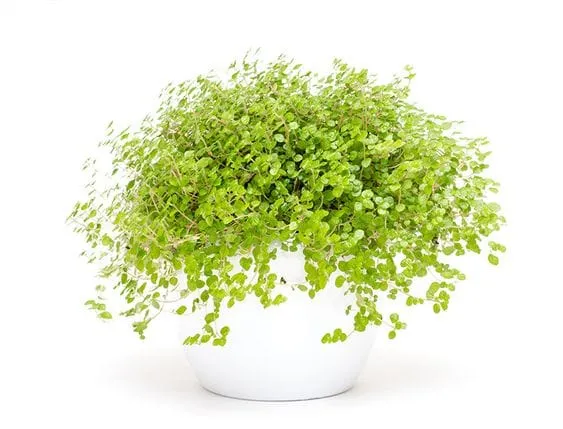
Source: GardenBeast (Pinterest)
Peace Lily
Peace lilies are popular for their air-purifying capabilities, thriving in low light and requiring minimal maintenance. With their elegant white blooms and glossy green leaves, they are a favorite among homeowners. This plant enhances air quality by filtering out contaminants, such as formaldehyde, benzene, and ammonia, and it helps regulate humidity levels.
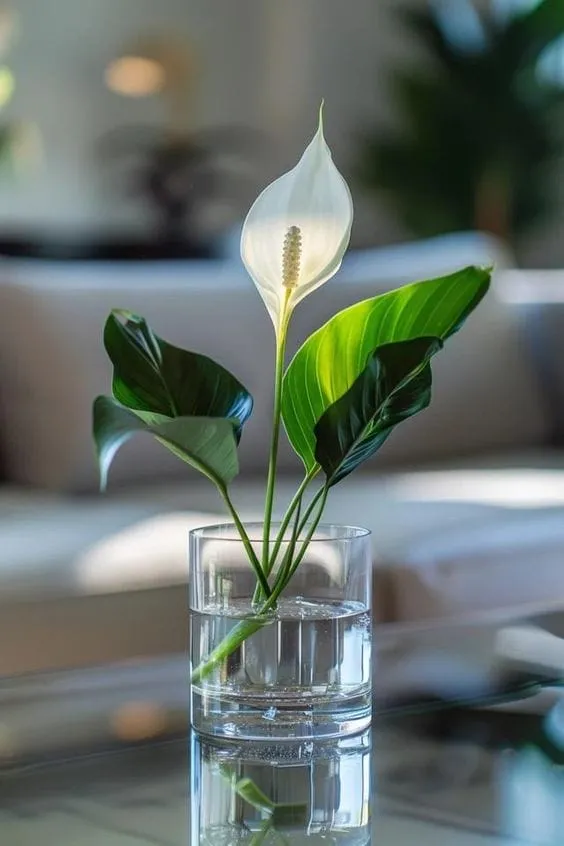
Source: Maison Lyle Interior Design (Pinterest)
Begonias
Begonias, with their thick, succulent stems, are resilient and easy to propagate in water. Hardy wax begonias, known for their distinctive knobby leaf nodes, root effortlessly. Even the more delicate rex begonias and tuberous begonias thrive in water, requiring just a single leaf to start a new plant. This makes begonias a versatile and attractive choice for indoor water gardening.
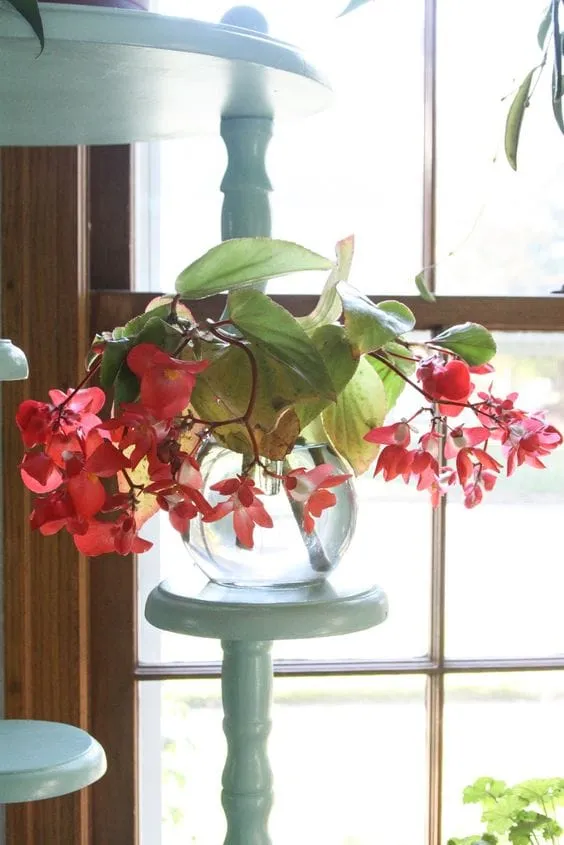
Source: My Giant Strawberry (Pinterest)
Impatiens
Impatiens, commonly used in shady gardens, thrive in moist environments and can grow as marginal pond plants. To propagate, snip off a few stems at the end of the growing season and place them in a vase of water. Over winter, these stems will root and grow, providing you with clones of the parent plant. This method ensures a free supply of impatiens to plant in your garden come spring.
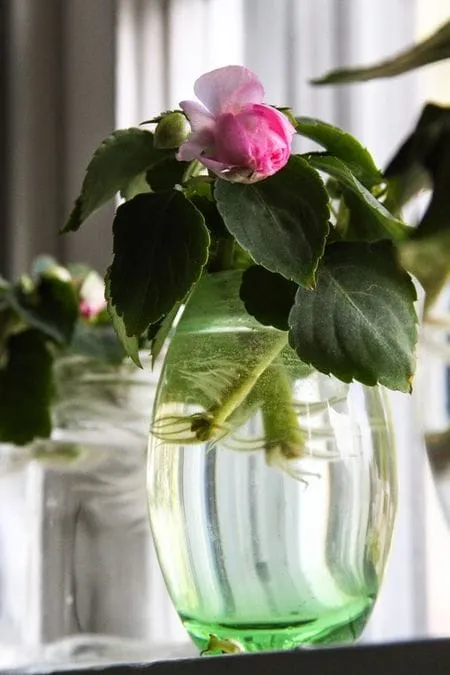
Source: The Spruce (Pinterest)
Coleus
Coleus, known for their vibrant, tropical foliage, are increasingly popular and can be quite costly. However, they are easy to propagate in water, making it simple to expand your collection. Take a six-inch cutting and remove the leaves from the bottom four inches. Place the cutting in a glass or vase of water. Roots will start forming in a few weeks. For optimal growth, add a bit of compost tea to the water during monthly changes.
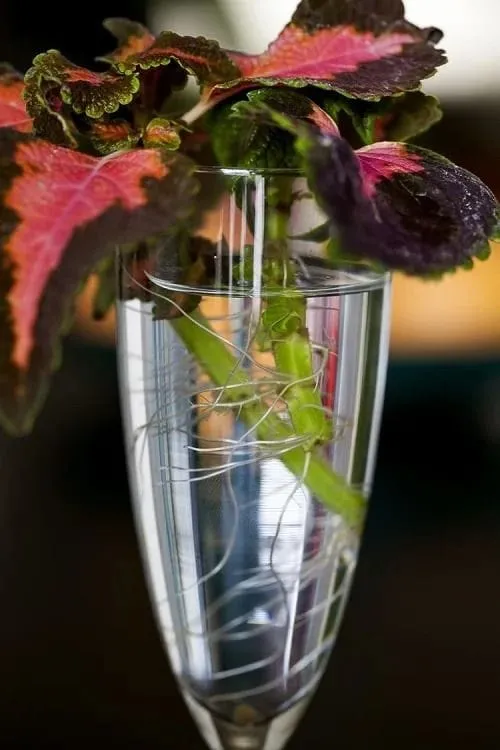
Source: Balcony Garden Web (Pinterest)
Lucky Bamboo
Lucky bamboo, with its hardy stalks, makes an elegant living centerpiece that thrives without soil. Growers often shape the stalks into spirals or woven designs, adding a unique aesthetic. However, these intricate shapes can make the plant top-heavy. To support the plant and enhance its ornamental value, surround the stalks with colorful gravel or rocks. This provides stability and adds a decorative touch to your indoor space.

Source: Wild Roots (Pinterest)
English Ivy
English ivy, a climbing vine known for its evergreen leaves, is highly adaptable and easy to grow. To propagate, simply take cuttings and place them in water. Remove any bottom leaves and put the cuttings in a jar on a well-lit windowsill. In about two to three weeks, roots will begin to appear, allowing you to grow this versatile plant indoors.
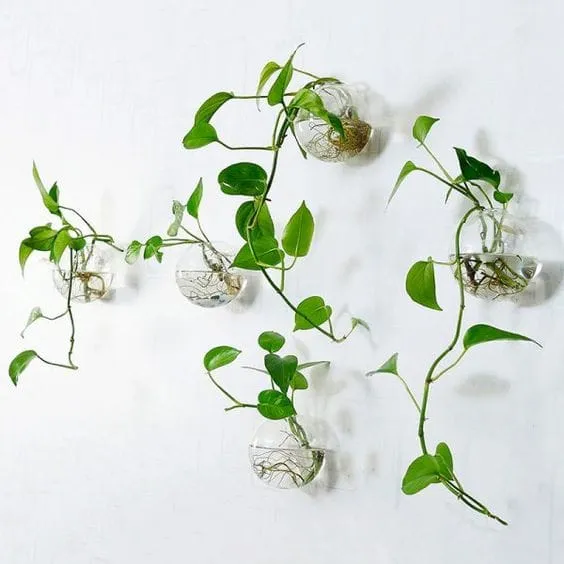
Source: Home Designing (Pinterest)
Philodendron
Philodendrons are perfect for water cultivation and are an excellent choice for beginners. This hardy houseplant can donate several stems for water growth without any issues. These cuttings look attractive when displayed in vases of various sizes and colors. Philodendrons thrive in different light conditions. However, if you notice more stem growth than leaves, placing them in brighter light will encourage leaf production.

Source: Martha Stewart (Pinterest)
Pancake Plant
Also known as the coin plant for its charming, coin-shaped leaves, the pancake plant is low-maintenance and thrives in water. You can either transfer an already rooted plant into a water container or take a stem cutting and submerge it in water. The stem will begin to form roots within a few weeks. To compensate for the nutrients provided by soil or rainwater, add houseplant or hydroponics fertilizer once a month. Change the water every two weeks or sooner if it becomes murky.

Source: Balcony Garden Web (Pinterest)
Lotus
Lotus, with their round petals and radial notch, are a stunning addition, often appearing to float above the water’s surface. These plants have root structures that grow below the muddy surface, sending stems above the water. You can mimic this growth with a dwarf lotus plant in a shallow six-inch bowl filled with pea gravel to anchor the root. During the regular growing season, provide hydroponic nutrients but cease fertilizing during the dormant winter months. Change the water every few weeks when it starts to look murky. Lotus plants thrive in bright, full sun and temperatures above 32 degrees Fahrenheit. They cannot survive temperatures below freezing.

Source: GardenBeast (Pinterest)
How to Grow Plants in Water?
Many indoor plants can thrive by propagating cuttings in a water-only medium, using almost any vessel that holds water. Glass jars and vases are popular because they allow you to see the plant’s roots; however, glass can lead to algae blooms. If you prefer low-maintenance gardening, consider using an opaque vase to minimize this issue.
Before placing your plant on a windowsill, verify its light exposure requirements. Different plants need varying amounts of sunlight and some thrive in the shade. Regularly change the water, preferably using chlorine-free water. To ensure your plants get the nutrients they absorb from soil, fertilize them with a water-soluble fertilizer at 1/4 strength.
Indoor Water Plants: Common Problems
Algae Growth
Algae can be a persistent problem for indoor water plants. To reduce algae growth, limit light exposure, minimize nutrients in the water, change the water frequently, and remove excess organic matter regularly.
Root Rot
Root rot is often caused by overwatering and poor water circulation. Prevent this by ensuring good water circulation and avoiding overwatering. Regularly trim any damaged roots and replace the water to keep the roots healthy.
Pests
Pests can affect indoor water plants. Inspect your plants frequently and isolate any affected ones to prevent the pests from spreading. If necessary, treat the plants with an aquatic-safe pesticide to eliminate pests.
Conclusion
Indoor water plants offer a delightful and low-maintenance way to enhance your home’s aesthetic while bringing freshness. Whether you choose to place them on a windowsill, a countertop, or as a centerpiece, these plants bring life and vibrancy to any room. These plants are visually appealing and provide numerous benefits, such as air purification and humidity regulation. From the delicate Baby’s Tears to the resilient Peace Lily and the vibrant Coleus, there is a water plant to suit your taste and décor. Growing indoor water plants is relatively simple, requiring minimal upkeep and effort. By following basic care guidelines, such as regular water changes, adequate light exposure, and occasional fertilization, you can ensure these plants thrive in your home. Additionally, being aware of common issues and taking preventive measures can maintain the health of your plants.
